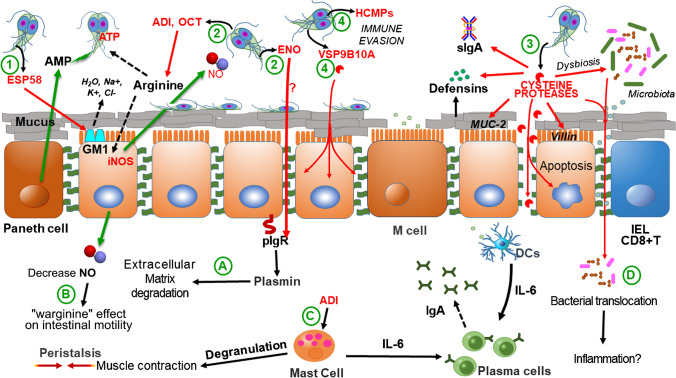Fig. 1.
Role of Giardia duodenalis virulence factors in pathogenicity. After excystation, trophozoites attach to intestinal epithelium and they adapt to the host intestinal microenvironment where they release a series of molecules with different reported effects. ESP58, a toxin-like protein recognizing a surface receptor in enterocytes (GM1) promotes water and electrolyte leakage (1). Energy metabolism enzymes have been detected in secretomes, including arginolytic enzymes such as gADI and gOCT that compete for arginine with intestinal cells, and glycolytic enzymes such as gENO that bioinformatics approaches indicate that it interacts with human plasminogen (2). Cysteine proteinases such as GL50803_16160, GL50803_16779 and giardipain-1 which degrade MUC2, villin, defensins and immunoglobulins; in microbiota biofilms these proteinases cause its disaggregation, alters microbiota composition (dysbiosis) and facilitate bacterial translocation (3). High-cysteine surface proteins such as HCMPs that are involved in immune evasion and VSPs such as VSP9B10A that display cysteine proteinase activity and have a cytotoxic effect on epithelial cells (4). These virulence factors have some effects at the intraepithelial level which include gENO-mediated conversion of plasminogen into plasmin that promotes extracellular matrix degradation (A), a “warginine” effect on intestinal motility through decreased in NO production (B), muscle contraction involving IgE-independent degranulation of mast cells by gADI (C), and bacterial translocation facilitated by giardial cysteine proteases that could promote inflammatory responses as IBD (D). Modified from [22]

